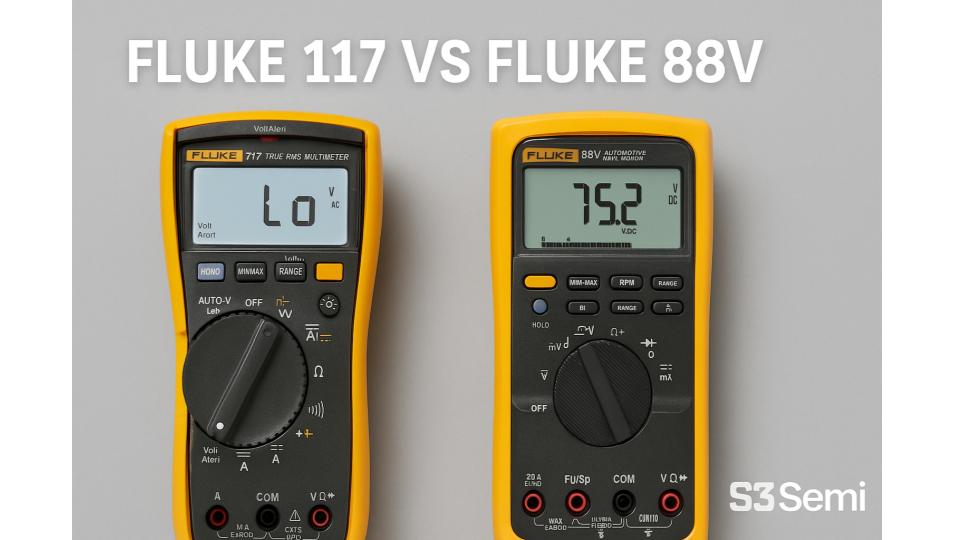Fluke makes some of the most trusted multimeters in the world, but not all models are built for the same purpose. Fluke 117 and the Fluke 88V are frequently compared.
🏷️ Fluke Multimeter Deals ⭐⭐⭐⭐
While both are reliable, durable, and accurate, they serve very different user groups. Let’s break down the differences to help you decide which one is best for your work.
📊 Comparison Table: Fluke 117 vs Fluke 88V
| Feature | Fluke 117 | Fluke 88V |
|---|---|---|
| Target User | Electricians | Automotive Technicians |
| True-RMS | ✅ | ✅ |
| Voltage Measurement | Up to 600V AC/DC | Up to 1000V AC/DC |
| Current Measurement | Up to 10A | Up to 20A (30s overload) |
| Resistance, Continuity, Capacitance | ✅ | ✅ |
| Frequency Measurement | ✅ | ✅ |
| Non-Contact Voltage Detection | ✅ (VoltAlert) | ❌ |
| LoZ (Ghost Voltage Elimination) | ✅ | ❌ |
| AutoVolt (AC/DC Selection) | ✅ | ❌ |
| Automotive-Specific Functions | ❌ | ✅ (RPM, duty cycle, pulse width, temp) |
| Display | Large backlit | Large backlit, enhanced durability |
| Safety Rating | CAT III 600V | CAT III 1000V / CAT IV 600V |
| Price | 💲 Check Price | 💲 Check Price |
📋 Overview of the Fluke 117
The Fluke 117 is designed for electricians working in residential and commercial settings. Compact and easy to use, it covers all the essential functions needed for day-to-day troubleshooting.
Key Features:
- True-RMS for accurate readings on non-linear loads.
- VoltAlert™ non-contact voltage detection.
- LoZ (Low Input Impedance) to eliminate ghost voltages.
- AutoVolt automatic AC/DC voltage selection.
- Measures voltage, current (up to 10A), resistance, continuity, frequency, and capacitance.
- Large backlit display for low-light conditions.
- Safety rating: CAT III 600V.
Best for: Electricians and technicians who need a compact, versatile multimeter for building and electrical systems.
📋 Overview of the Fluke 88V
The Fluke 88V is part of Fluke’s Automotive Series. Built with advanced functionality, it is specifically designed for diagnosing automotive electrical and electronic systems.
Key Features:
- True-RMS accuracy.
- Measures AC/DC voltage up to 1000V.
- Current measurement up to 20A (30 seconds overload protection).
- Automotive-specific tests: duty cycle, pulse width, RPM, temperature, and millisecond measurements.
- Peak min/max recording to capture intermittent issues.
- Safety rating: CAT III 1000V / CAT IV 600V.
- Rugged casing with enhanced durability.
Best for: Automotive technicians who need advanced features for diagnosing vehicles and electronic control systems.
👍 Pros & Cons of Each
Fluke 117
Pros:
- Compact and easy to carry.
- AutoVolt and LoZ features save time.
- VoltAlert provides quick non-contact voltage detection.
- Great value for electricians.
Cons:
- Limited to 600V and 10A.
- No automotive testing functions.
- Lower safety category compared to 88V.
Fluke 88V
Pros:
- Wide voltage (1000V) and current (20A) range.
- Automotive functions (RPM, duty cycle, temperature).
- Higher safety rating (CAT IV 600V).
- Rugged and durable for workshop use.
Cons:
- Bulkier than the 117.
- More expensive.
- Overkill for general electrical work.
🏁 Which One Should You Choose?
- Pick the Fluke 117 if you’re an electrician or technician working in residential or commercial buildings. Its compact design, LoZ function, and non-contact voltage detection make it perfect for everyday troubleshooting.
- Pick the Fluke 88V if you’re an automotive professional. Its specialized functions like RPM, duty cycle, and temperature measurement make it the ideal tool for diagnosing vehicles and electronic control systems.
In short: Fluke 117 = Best for Electricians. Fluke 88V = Best for Automotive Technicians.



